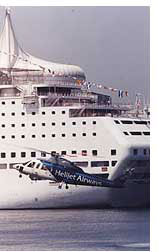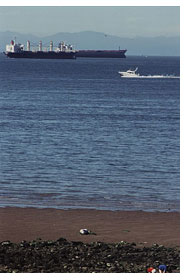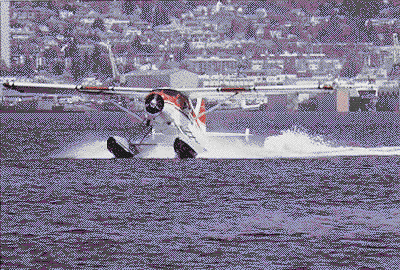|

About
the Port of Vancouver
Story
and photos by Ed Anderson
 Home-port
for Vancouver-Alaska cruises, Vancouver, British
Columbia welcomes more than 1,000,000 passengers at
its Canada Place and Ballantyne
terminals.
The
Port of Vancouver offers Cruise customers:(1)
Modern, comfortable and safe cruise facilities near
both downtown and the airport.(2) Terminals that
accommodate the largest cruise ships afloat.(3) A
sailing time to Alaska that allows sufficient time
to enjoy an extensive Alaska
itinerary.
The
Port of Vancouver is comprised of 26 cargo and Home-port
for Vancouver-Alaska cruises, Vancouver, British
Columbia welcomes more than 1,000,000 passengers at
its Canada Place and Ballantyne
terminals.
The
Port of Vancouver offers Cruise customers:(1)
Modern, comfortable and safe cruise facilities near
both downtown and the airport.(2) Terminals that
accommodate the largest cruise ships afloat.(3) A
sailing time to Alaska that allows sufficient time
to enjoy an extensive Alaska
itinerary.
The
Port of Vancouver is comprised of 26 cargo and
 other
marine related terminals to provide a full range of
facilities and services to the international
shipping community. Most terminals are centrally
located in Vancouver's Burrard Inlet. The
exceptions are the Deltaport container terminal,
and Westshore Terminals' coal handling facility,
which are located at Roberts Bank, 22 km from the
city centre. Collectively, Port of Vancouver
terminals offer virtually no draft restrictions,
post-Panamax capacity, and among the most extensive
on-dock rail facilities of any North American West
Coast port. other
marine related terminals to provide a full range of
facilities and services to the international
shipping community. Most terminals are centrally
located in Vancouver's Burrard Inlet. The
exceptions are the Deltaport container terminal,
and Westshore Terminals' coal handling facility,
which are located at Roberts Bank, 22 km from the
city centre. Collectively, Port of Vancouver
terminals offer virtually no draft restrictions,
post-Panamax capacity, and among the most extensive
on-dock rail facilities of any North American West
Coast port.
Bulk
cargoes account for more than 81% of the port's
annual throughput. Coal, sulphur, potash, grain,
petro-chemicals and woodchips are typical of the
bulk shipments which are handled through the port's
17 bulk terminals.
 There
are nine general cargo terminals. Forest products
such as lumber, plywood, pulp, and newsprint
account for 96% of general cargo, and 6% of the
port's total cargo volumes. General cargo also
includes project cargo. There
are nine general cargo terminals. Forest products
such as lumber, plywood, pulp, and newsprint
account for 96% of general cargo, and 6% of the
port's total cargo volumes. General cargo also
includes project cargo.
Two
container terminals, Centerm and Vanterm, are
located in the port's inner harbour. The Deltaport
container terminal in the outer harbour officially
opened in 1997. Deltaport doubled the port's
container capacity to more than 1.2 million TEUs
per year.
The
inner harbour of Vancouver British Columbia -
considered one of the best deepwater ports in the
world - has also become over the past 20 years, an
important Pacific Northwest terminus for commercial
sea/float plane and helicopter activity. According
to the latest stats, the year 200O saw some 60,000
landings and take-offs in the harbour, comprising
mostly commercial and scheduled traffic carrying
thousands of passengers and cargo, ranking this the
fifth busiest airport in British Columbia.
 The
Vancouver air harbour is unique and fascinating.
But like all busy places, the end of a warm summers
day often brings a welcome, peaceful calm to these
inlet waters, disturbed only by the distant hum of
a round engine, emanating from the silhouette of a
Beaver Floatplane heading out over the lights on
Lions Gate Bridge, before fading into a brilliant
west coast sunset. Pretty hard to beat, even in
Hawaii. The
Vancouver air harbour is unique and fascinating.
But like all busy places, the end of a warm summers
day often brings a welcome, peaceful calm to these
inlet waters, disturbed only by the distant hum of
a round engine, emanating from the silhouette of a
Beaver Floatplane heading out over the lights on
Lions Gate Bridge, before fading into a brilliant
west coast sunset. Pretty hard to beat, even in
Hawaii.
Approximately
sixty percent of the movements are float/seaplanes
and forty percent helicopters. Although the "High
season," May through September, posts the higher
movement numbers, especially with charters, regular
passenger and cargo flights continue to coastal
communities, the Gulf Islands, and Vancouver Island
through the rest of the year, including the poor
weather winter months.
"The
Vancouver air harbour is unique and
fascinating.
It ranks as 5th busiest airport in British
Columbia."
Its
own Control Tower:
As with all active flyways, rules and good conduct
are essential to safety, order and efficiency. NAV
Canada, the privatized spin off from the previous
governing authority, Transport Canada, oversees and
controls all aircraft activity about the harbour
and surrounding airspace within a box like zone of
roughly 3 square miles.
|